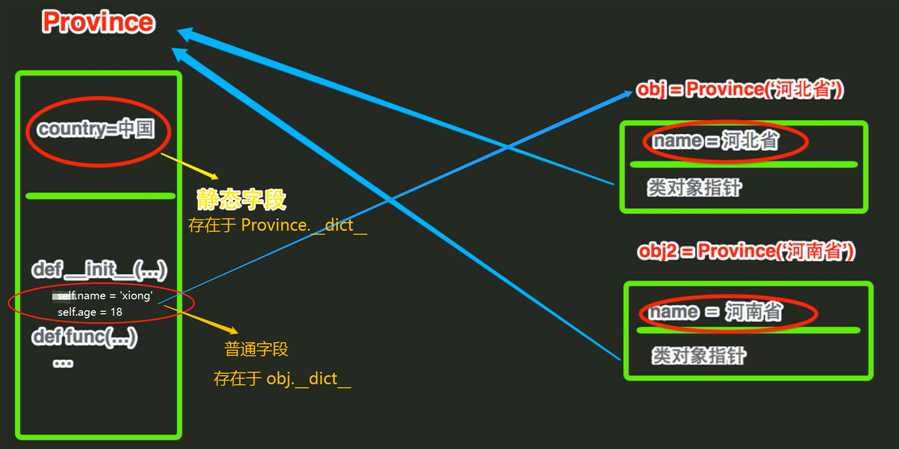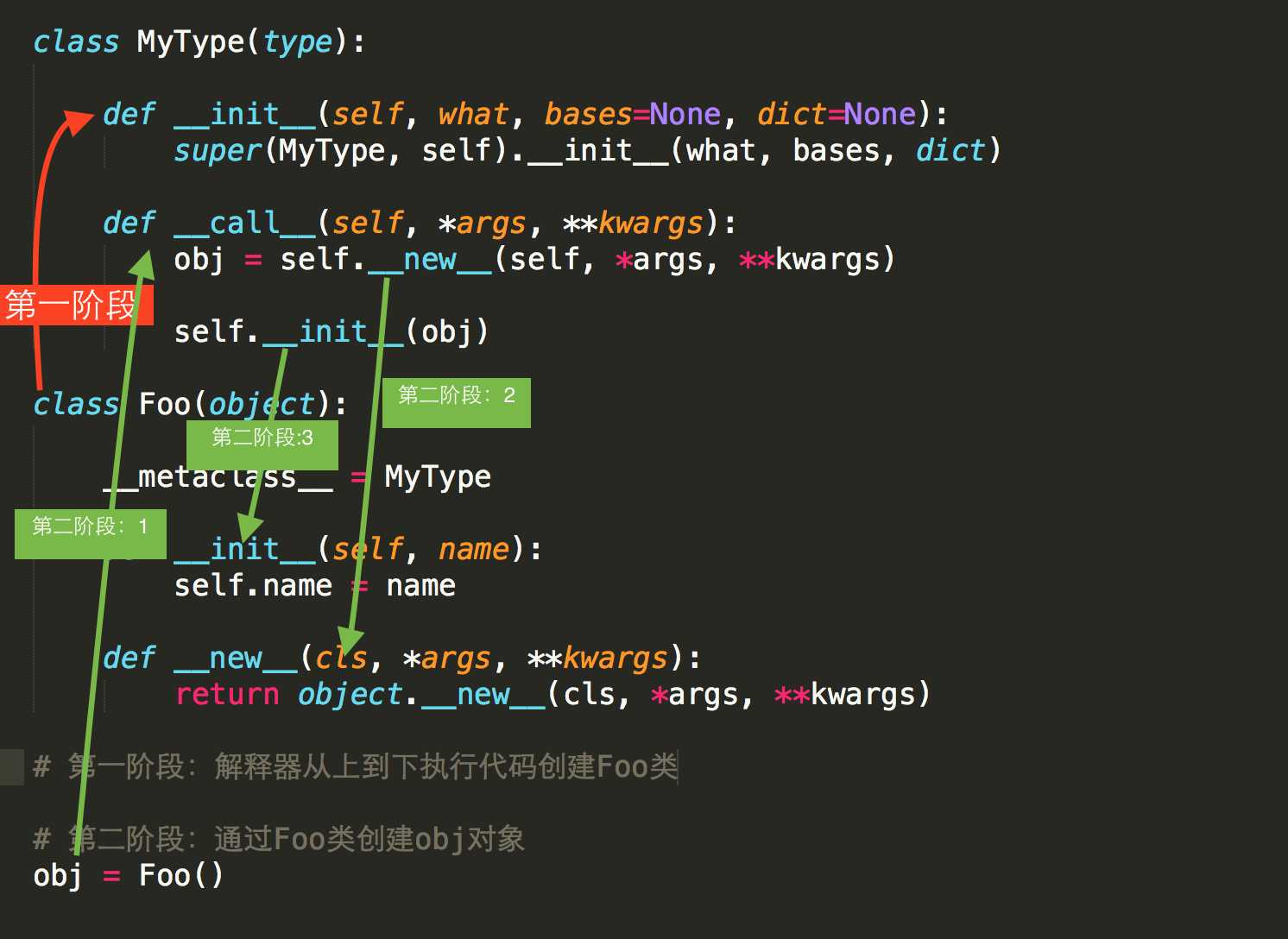标签:for ict 应该 opened 详情 列表 垃圾 基础 cli
类的成员可以分为三大类:字段、方法和属性。并且成员名前如果有两个下划线,则表示该成员是私有成员,私有成员只能由类内部调用。无论人或事物往往都有不按套路出牌的情况,Python的类成员也是如此,存在着一些具有特殊含义的成员,详情如下:
表示类的描述信息

class Foo: """ 描述类信息,这是用于看片的神奇 """ def func(self): pass print(Foo.__doc__)
__module__ 表示当前操作的对象在那个模块
__class__ 表示当前操作的对象的类是什么

class C: def __init__(self): self.name = ‘xiong‘

from lib.aa import C obj = C() print obj.__module__ # 输出 lib.aa,即:输出模块 print obj.__class__ # 输出 lib.aa.C,即:输出类
构造方法,通过类创建对象时,自动触发执行。

class Foo: def __init__(self, name): print(‘类实例化对象时自动执行‘) self.name = name self.age = 18 obj = Foo(‘xiong‘) # 自动执行类中的 __init__ 方法
析构方法,当对象在内存中被释放时,自动触发执行。
注:此方法一般无须定义,因为Python是一门高级语言,程序员在使用时无需关心内存的分配和释放,
因为此工作都是交给Python解释器来执行,所以,析构函数的调用是由解释器在进行垃圾回收时自动触发执行的。

class Foo: def __del__(self): print(‘执行我啦‘) f1=Foo() del f1 #删除实例对象,释放内存资源 触发__del__() print(‘------->‘) #输出结果: # 执行我啦 # ------->

# ---------------------------------一个坑? class Foo: def __del__(self): print(‘执行我啦‘) f1=Foo() print(‘------->‘) #输出结果 # -------> # 执行我啦 # # #为何啊??? # 程序执行完成之后会自动释放内存
对象后面加括号,触发执行。
注:构造方法的执行是由创建对象触发的,即:对象 = 类名() ;而对于 __call__ 方法的执行是由对象后加括号触发的,即:对象() 或者 类()()

class Foo: def __init__(self): print(‘实例化对象执行__init__‘) def __call__(self, *args, **kwargs): print(‘执行__call__‘) obj = Foo() # 执行 __init__ obj() # 执行 __call__
类或对象中的所有成员
上文中我们知道:类的普通字段属于对象;类中的静态字段和方法等属于类,即:


class Province: country = ‘China‘ #类中的静态字段 def __init__(self, name, count): self.name = name #类的普通字段 self.count = count #类的普通字段 def func(self, *args, **kwargs): print(‘func()方法属于类‘) # 获取类的成员,即:静态字段、方法、 print(Province.__dict__) # 输出:{‘country‘: ‘China‘, ‘__module__‘: ‘__main__‘, ‘func‘: <function func at 0x10be30f50>, ‘__init__‘: <function __init__ at 0x10be30ed8>, ‘__doc__‘: None} obj1 = Province(‘HeBei‘,10000) print(obj1.__dict__) # 获取 对象obj1 的成员 # 输出:{‘count‘: 10000, ‘name‘: ‘HeBei‘} obj2 = Province(‘HeNan‘, 3888) print(obj2.__dict__) # 获取 对象obj1 的成员 # 输出:{‘count‘: 3888, ‘name‘: ‘HeNan‘}
如果一个类中定义了__str__方法,那么在打印 对象 时,默认输出该方法的返回值。

class Too: pass t1 = Too() print(t1) # 输出:<__main__.Too object at 0x0000013313EC0198> class Foo: def __str__(self): return ‘这是默认的__str__返回值!‘ obj = Foo() print(obj) # 输出:这是默认的__str__返回值!
用于索引操作,如字典。以上分别表示获取、设置、删除数据

class Foo(object): def __init__(self,*args,**kwargs): self.args = args self.kwargs = kwargs def __getitem__(self, key): print(‘__getitem__‘, key) print(‘args==>‘,self.args,‘kwargs==>‘,self.kwargs) def __setitem__(self, key, value): print(‘__setitem__‘, key, value) def __delitem__(self, key): print(‘__delitem__‘, key) obj = Foo(‘xiong‘,‘zhejiang‘,school=‘ZJU‘,location=‘nb‘) result = obj[‘k1‘] # 自动触发执行 __getitem__ obj[‘k2‘] = ‘xiong‘ # 自动触发执行 __setitem__ del obj[‘k1‘] # 自动触发执行 __delitem__
该三个方法是Python2用于分片操作,如:列表,Python3已经整合到__getitem__中

class Foo(object): save_list = [1, 2, 3, 4, 5, 6, 34, 23, 5] def __getslice__(self, i, j): print "__getslice__:" return self.save_list[i: j] def __setslice__(self, i, j, sequence): print "__setslice__:" self.save_list[i:j] = sequence print self.save_list def __delslice__(self, i, j): print "__delslice__:" del self.save_list[i: j] print self.save_list obj = Foo() result = obj[1: 2] print(result) obj[0: 1] = [23, 22, 15, 4] del obj[4:] """ 结果: __getslice__: [2] __setslice__: [23, 22, 15, 4, 2, 3, 4, 5, 6, 34, 23, 5] __delslice__: [23, 22, 15, 4] """
用于迭代器,之所以列表、字典、元组可以进行for循环,是因为类型内部定义了 __iter__ 并且有next() 方法

class Foo(object): pass obj = Foo() for i in obj: print(i) # 报错:TypeError: ‘Foo‘ object is not iterable

class Foo(object): def __iter__(self): pass obj = Foo() for i in obj: print(i) # 报错:TypeError: iter() returned non-iterator of type ‘NoneType‘

class Foo(object): def __init__(self, sq): self.sq = sq def __iter__(self): return iter(self.sq) obj = Foo([11,22,33,44]) for i in obj: print(i) #11 22 33 44
以上步骤可以看出,for循环迭代的其实是 iter([11,22,33,44]) ,所以执行流程原理就是:
obj = iter([11,22,33,44]) for i in obj: print i

obj = iter([11,22,33,44]) while True: try: # val = obj.__next__() val = next(obj) # obj.__next__() <===> next(obj) print(val) except: break
阅读以下代码:
class Foo(object): def __init__(self): pass obj = Foo() # obj是通过Foo类实例化的对象
上述代码中,obj 是通过 Foo 类实例化的对象,其实,不仅 obj 是一个对象,Foo类本身也是一个对象,因为在Python中一切事物都是对象。
如果按照一切事物都是对象的理论:obj对象是通过执行Foo类的构造方法创建,那么Foo类对象应该也是通过执行某个类的 构造方法 创建。
print(type(obj)) # 输出:<class ‘__main__.Foo‘> 表示,obj 对象由Foo类创建 print(type(Foo)) # 输出:<type ‘type‘> 表示,Foo类对象由 type 类创建
所以,obj对象是Foo类的一个实例,Foo类对象是 type 类的一个实例,即:Foo类对象 是通过type类的构造方法创建。
那么,创建类就可以有两种方式:
a). 普通方式 class
class Foo(object): def func(self): print(‘hello xiong‘)
b).特殊方式(type类的构造函数)
def func(self): print ‘hello wupeiqi‘ Foo = type(‘Foo‘,(object,), {‘func‘: func}) #type第一个参数:类名 #type第二个参数:当前类的基类 #type第三个参数:类的成员
==》 类 是由 type 类实例化产生
那么问题来了,类默认是由 type 类实例化产生,type类中如何实现的创建类?类又是如何创建对象?
答:类中有一个属性 __metaclass__,其用来表示该类由 谁 来实例化创建,所以,我们可以为 __metaclass__ 设置一个type类的派生类,从而查看 类 创建的过程。


class MyType(type): def __init__(self, what, bases=None, dict=None): super(MyType, self).__init__(what, bases, dict) def __call__(self, *args, **kwargs): obj = self.__new__(self, *args, **kwargs) self.__init__(obj) class Foo(object): __metaclass__ = MyType def __init__(self, name): self.name = name def __new__(cls, *args, **kwargs): return object.__new__(cls, *args, **kwargs) # 第一阶段:解释器从上到下执行代码创建Foo类 # 第二阶段:通过Foo类创建obj对象 obj = Foo()
元类:__metaclass__ 详细参考:http://www.cnblogs.com/linhaifeng/articles/8029564.html
标签:for ict 应该 opened 详情 列表 垃圾 基础 cli
原文地址:https://www.cnblogs.com/XJT2018/p/10898336.html